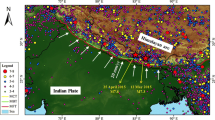Abstract
The spatial damage distribution of August 16, 2003, Inner Mongolia, China, M S=5.9 earthquake is summarized through field investigation. The moment tensor solution and focal mechanism are inverted using the digital long-period waveform records of China Digital Seismograph Network (CDSN). The relation between the spatial damage distribution and focal mechanism is analyzed according to the focal mechanism, the aftershock distribution and the spatial damage distribution. The possible relation between the characteristics of ground motion and the tectonic background of the source region is discussed in terms of the global ground motion records, historical earthquake documents and the damage distribution. Investigation reveals that the meizoseismal region is in east-west direction, which is consistent with the nodal plane of focal mechanism inversion. The meizoseismal area is relatively large and the damage of single-story adobe houses or masonry houses is more severe. This may have relations with local seismotectonic environment.
Similar content being viewed by others
References
Aki K and Richards P G. 1980. Quantitative Seismology Theory and Methods [M]. Vols. 1 and 2. San Francisco: Freeman, 1–932.
Anderson J G, Bodin P, Brune J et al. 1986. Strong ground motion and source mechanism of the Mexico earthquake of September 19, 1985 [J]. Science, 233: 1 043–1 049.
Anderson J G, Brune J N, Anooshehpoor R et al. 2000. New ground motion data and concepts in seismic hazard analysis [J]. Current Science, 79: 1 278–1 290.
Archuleta R J and Hartzell S H. 1981. Effects on fault finiteness on near-source ground motion [J]. Bull Seism Soc Amer, 71: 939–957.
CHEN Yun-tai, WU Zhong-liang, WANG Pei-de et al. 2000. Digital Seismology [M]. Bei**g: Seismological Press, 1–171 (in Chinese).
Kennett B L N and Engdahl E R. 1991. Travel times for global earthquake location and phase identification [J]. Geophys J Int, 105: 429–465.
Kennett B L N. 1983. Seismic Wave Propagation in Stratified Media [M]. London: Cambridge University Press, 1–339.
Lay T and Wallace T C. 1995. Modern Global Seismology [M]. San Diego: Academic Press, 1–521.
LIU Li-qiang, MA Sheng-li, MA ** et al. 2001. Temporal scanning of b-value and spectrum of AE activity for samples with different textures and their physical implications [J]. Seismology and Geology, 23(4): 481–492 (in Chinese).
Luco J E and Anderson J G. 1983. Steady state response of an elastic half-space to a moving dislocation of finite fault [J]. Bull Seism Soc Amer, 73: 1–22.
Somerville O G, Smith N F, Graves R W et al. 1997. Modification of empirical strong ground motion attenuation relations to include the amplitude and duration effects of rupture directivity [J]. Seismol Res Lett, 68: 199–222.
Sondergeld C H and Estey L H. 1981. Acoustic emission study during the cyclic loading of westerly granite [J]. J Geophys Res, 86: 2915–2924.
Spudich P, Joyner W B, Lindh A G et al. 1999. SEA99: A revised ground motion prediction relation for use in extensional tectonic regimes [J]. Bull Seism Soc Amer, 89: 1156–1170.
Tsai Y B and Huang M W. 2000. Strong ground motion characteristics of the Chi-chi, Taiwan earthquake of September 21, 1999 [J]. Earthq Engin and Engin Seism, 2: 1–21.
WANG Su-yun, GAO A-jia, YAN **u-jie. 2000. Development of attenuation relations for ground motion in China [J]. Journal of Earthquake Prediction Research, 8(1): 32–40.
XU Li-sheng, CHEN Yun-tai, GAO Meng-tan. 2002. Spatial and temporal rupture process of the January 26, 2001, Gujarat, India, M s=7.8 earthquake [J]. Acta Seismologica Sinica, 15(5): 469–483.
XU Li-sheng, CHEN Yun-tai. 1997. Source parameters of the Gonghe, Qinghai Province, China, earthquake from inversion of digital broadband waveform data [J]. Acta Seismologica Sinica, 10(2): 143–159.
ZHAO Shu-qing. 1986. Frequency spectra characteristics of acoustic emission signals during fracturing of rock specimen and a discussion of earthquake prediction [A]. In: PU Guang-zhi eds. Advances in Science of China-Earth Science [C]. Bei**g: Science Press. 19–34.
Author information
Authors and Affiliations
Additional information
Foundation item: The Special Funds for Major State Basic Research Project (2002CB412706).
Contribution No. 05FE3009, Institute of Geophysics, China Earthquake Administration.
About this article
Cite this article
Gao, Mt., Xu, Ls., Guo, Ws. et al. Spatial damage distribution of August 16, 2003, Inner Mongolia, China, M S=5.9 earthquake and analysis. Acta Seimol. Sin. 18, 218–225 (2005). https://doi.org/10.1007/s11589-005-0069-x
Received:
Revised:
Accepted:
Issue Date:
DOI: https://doi.org/10.1007/s11589-005-0069-x




